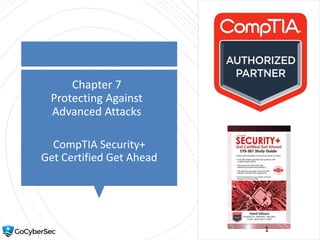
501 ch 7 advanced attacks
- 1. Chapter 7 Protecting Against Advanced Attacks CompTIA Security+ Get Certified Get Ahead 1
- 2. Introduction • Comparing common attacks • Summarizing secure coding concepts • Identifying application attacks • Understanding frameworks and guides
- 3. Common Attacks • Denial-of-service (DoS) – Comes from one system • Distributed denial-of-service (DDoS) – Multiple attacking computers – Typically include sustained, abnormally high network traffic
- 4. Common Attacks • Privilege escalation – Gain additional privileges after initial exploit • Spoofing – Impersonating or masquerading as someone or something else – MAC spoofing – IP spoofing
- 5. Common Attacks • SYN flood attack – Common attack against Internet servers – Disrupts the TCP three-way handshake – Withholds 3rd packet
- 6. Common Attacks • Man-in-the-middle – Active interception – Active eavesdropping • ARP poisoning
- 7. Password Attacks • Online password attack – Attempts to discover a password from an online system • Online password attack – Attempts to discover passwords from a captured database or captured packet scan
- 8. Password Attacks • Password hashes – Password: IC@nP@$$S3curity+ – Hash 75c8ac11c86ca966b58166187589cc15 • http://www.md5online.org/ – Password 12345 – Hash 827ccb0eea8a706c4c34a16891f84e7b
- 9. Common Attacks • Known plaintext – Attacker has samples of both the plaintext and the ciphertext • Compare with chosen plaintext The information contained in this email and any accompanying attachments may contain proprietary information about the Pay & Park & Pay parking garage. Nr55tySu3IFIf7f3Cjn540fSs0j0QbshCN0yOAvhN3UKr85uE kvawEPG3lhLIklwBz7hBzhaRZ96KUYIT3wQbf2cSkWHtN8Z QrQ+ZGJHhe8HkL42CPjHIGc0HW4urJ+NNLnNxqHyRo34a zbnXsd3qd3Ce5GE7blWtY0duwNKy0xqhmDihUJs9nDhXB V4nBkZ6shcmKGEUSyvCr/hOEpAYw==
- 10. Common Attacks • Typo squatting / URL hijacking – Attackers purchase similar domain names for various malicious purposes – Users visit the typo squatting domain when they enter the URL incorrectly with a common typo • Clickjacking – Tricks users into clicking something different – Typically uses frames
- 11. Common Attacks • Session hijacking – Impersonate the user with the session ID – Session IDs stored in cookies • Domain hijacking – Attacker changes the registration of the domain name – Typically done by using social engineering techniques to guess owner’s password
- 12. Common Attacks • Zero-day vulnerabilities – Undocumented and unknown to the public – Vendor might know about it, but has not yet released a patch to address it • Zero day attack – Attempts to exploit zero-day vulnerabilities – Also known as zero day- exploit
- 13. Memory Buffer Vulnerabilities Application bugs • Memory leak – App consumes more and more memory – Can crash operating system • Integer overflow – App attempts to use or create numeric value too big for the available storage – 8-bit storage – 95 x 59 = 5,605 (needs at least 13 bits to store)
- 14. Memory Buffer Vulnerabilities • Buffer overflow and buffer overflow attack – Occur when an application receives data that it can’t handle – Exposes system memory – Often includes NOP instructions (such as x90) – Can then insert malicious code into memory – Input validation helps prevent buffer overflow attacks
- 15. Secure Coding Concepts • Compiled code – Optimized – Run as an executable – Compiler checks the program for errors and • Runtime code – Code is evaluated, interpreted, and executed when the code is run – HTML is interpreted by web browsers and displayed as web pages
- 16. Input Validation • Verifies validity of data before using it – Verifies proper characters – Uses boundary and/or range checking – Blocks HTML code – Prevents the use of certain characters • Client-side vs server-side – Server-side is more secure (many sites use both) • Input validation prevents – Buffer overflow, SQL injection, command injection, and cross-site scripting attacks
- 17. Secure Coding Concepts • Avoid race conditions – Occur when two modules attempt to access the same resource – First module to complete the process wins – Database locks prevent race conditions
- 18. Error and Exception Handling • Catch errors and provides feedback – Prevent improper input from crashing an application providing information to attackers – Errors to users should be general – Logged information should be detailed
- 19. Secure Coding Concepts • Cryptographic techniques – Encryption – Authentication – Code signing
- 20. Secure Coding Concepts • Code reuse – Avoid dead code • Software development codes (SDKs) – Provide software tools easy to reuse • Code obfuscation – Camouflage code
- 21. Code Quality and Testing • Static code analyzers • Dynamic analysis • Stress testing • Sandboxing • Model verification
- 22. SDLC Models Software development life cycle (SDLC) models • Waterfall – Multiple stages going from top to bottom – Strict • Agile – Starts with set of principles – Uses iterative cycles with incremental changes – Flexible
- 23. Secure DevOps • Security automation • Continuous integration • Baselining • Immutable systems • Infrastructure as code
- 24. Secure Coding Concepts • Change management – Ensures developers do not make unauthorized changes – Provides accounting structure • Version control – Tracks software versions – Identifies who made the change and when
- 25. Secure Coding Concepts • Provisioning (an application) – Preparing to deploy it – Configuring for different applications • Deprovisioning (an application) – Removing it completely
- 26. Application Attacks • Web servers host web sites – Apache – IIS • Protected by placing in DMZ
- 27. Application Attacks • Cross-site scripting (XSS) – Attackers embed malicious HTML or JavaScript code – Can be in web site or links in email – Prevented with server-side input validation – OWASP recommends use of library
- 28. Frameworks and Guides • Frameworks – Regulatory – Non-regulatory – National versus international – Industry-specific • Guides – Vendor-specific – Platform-specific – Role- or goal-specific
- 29. Chapter 7 Summary • Comparing common attacks • Summarizing secure coding concepts • Identifying application attacks • Understanding frameworks and guides